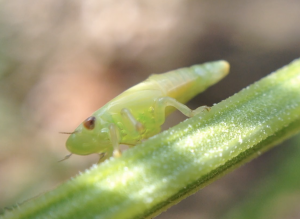What’s actually inside the cuckoo spit? IMPORTANT INFORMATION re Xylella fastidiosa BELOW
I was always amazed as a young lad in Liverpool whenever I examined the spit I found, usually on waste ground or in Sefton Park, a few miles from home. What would spit on plants and the spit would stay there I wondered? Looking inside you would find a delicate little spittlebug nymph living inside the spittle. Thinking about it I thought it would give this soft-bodied bug some protection from spiders, birds, ants, and other predators. What a great place to hide! It would also keep it cool and moist in the summer which was the only time I found them. It sucks sap from the plant and excretes it as foam as protection. How cool is that!

You can see why it is called a froghopper!
Other than that, it was a while until I realised that they looked like those jumping froglike bugs that jumped so high and far for such a small creature if you touched their rear end. I’m not the only person who was amazed at their jumping ability. Professor Malcolm Burrows found that they and not fleas, were the champion jumpers, using a novel catapult mechanism for their jumping ability.
The RHS states that they have a little detrimental effect on plants, though I suspect that depends upon how many there are on one plant or crop. Not surprisingly with their frog-like heads, they are called Froghoppers. So if you see any cuckoo spit in your garden have a look for yourself!
I really don’t know how cuckoo spit got that name. If you know then contact me and I can add that to this article! Thank you to all those people who have told me about this article by the RSPB re cuckoo spit.
Xylella fastidiosa
If you see cuckoo spit in your garden or in the countryside a team of scientists from the University of Sussex at the Insect Vectors of Plant Diseases would like your help and want you to submit sightings of spittle. Why? This information will be essential for deciding how best to respond should the Xylella fastidiosa bacterium arrive in the UK.
NB. From Dr Claire Harkin Brigit Research Consortium, “Froghoppers do not currently pose any threat in the UK. The Xylella bacteria has not arrived here yet, and consequently, there is no disease for the insects to transmit. This work is purely precautionary at this stage. We are doing our best to remind concerned members of the public that there is no need to disturb/kill the bugs, or to treat plants with spittle on, as there was some alarm when the story first came out.”
No Cure currently
It has been described by the EU Commission as “one of the most dangerous plant bacteria worldwide, causing a variety of diseases, with huge economic impact for agriculture, public gardens and the environment.” There is currently no cure for the disease which is known to affect more than 300 tree, shrubs, and herbaceous plants. It has already killed millions of trees and it has also been identified to be causing disease outbreaks in ornamental and native species, such as lavender, oleander, and rosemary, in France and Spain. It is transmitted by froghoppers/spittlebugs and some leafhoppers. There are around 18 species that could act as vectors a list and handy photograph guide is found here
More information about BRIGIT a collaboration to understand and prevent vector-borne plant pathogens to the UK
See BBC article Garden Insect is Jump Champion

If left unchecked they do kill the host plant.
I have never seen this myself, Penny, I must admit. I have n’t the time to start researching this though. Thanks for your comment. Cheers George
Hi I’ve noticed cuckoo spit on some mint in my garden!! Should I just leave it ? There seems to be more everyday !!
Plants have evolved to cater for these so I would leave them be.Cheers George NN